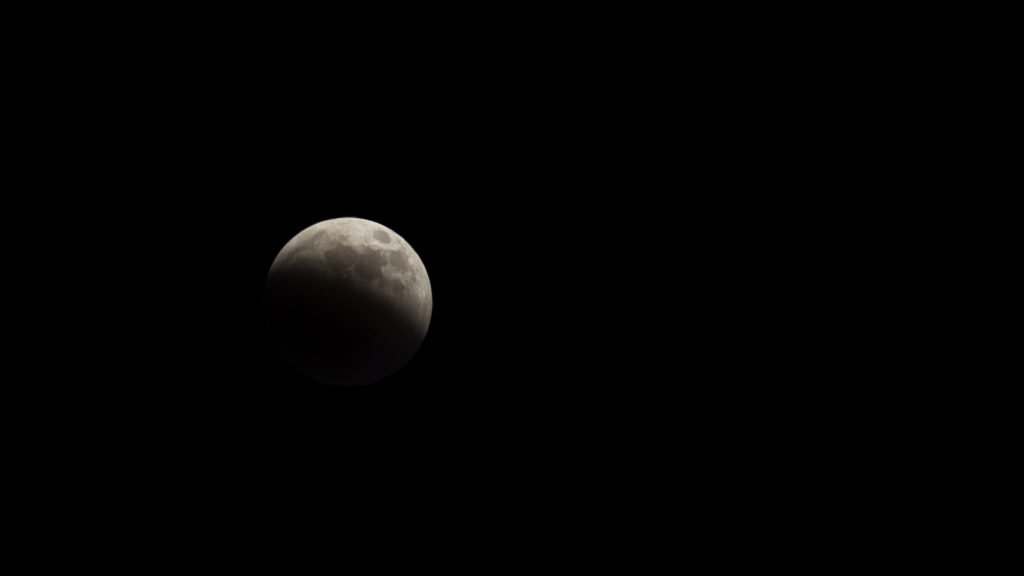It was wild, untamed music and it echoed from the hillsides and filled the valleys. It sent a queer shivering feeling along my spine. It was not a feeling of fear, you understand, but a sort of tingling, as if there was a hair on my back and it was hackling. – Alda Orton, Alaskan trapper
A moon at perigee, Rayleigh scattering and howling wolves led to this winter’s first full moon of the year eclipse phenomenon. Cloudy skies were predicted in my neck of the woods and I nearly missed the entire event. I peeked outside at around 10:30 pm, expecting to find dense clouds with zero visibility. Instead I saw hazy but clear skies lit by a partially eclipsed full moon. I hauled out my gear to brave the zero degree Fahrenheit (actual) temperatures and spent the next nearly three hours alternating between capturing images and warming up inside my house. From those images I produced the below video as my contribution to this week’s Super Blood Wolf Moon lunacy.
But what is a Super Blood Wolf Moon? The title is derived from the convergence of three unique lunar phases, the super moon, a lunar eclipse which is often called a blood moon, and the wolf moon.
Super Moon – The orbit of the moon around the earth is not circular but rather an elliptical path. The moon is at perigee when it approaches its closest points to the Earth along that ellipse and apogee at its furthest points from the earth. The super moon occurs during a full moon when it is at or near perigee.
Blood Moon – As the earth moves between the sun and the moon, earth-light is reflected back onto the surface of the moon, casting a reddish shadow and creating the “blood moon” effect. The reddish color is caused by a phenomenon known as Rayleigh Scattering which is “dispersion of electromagnetic radiation by particles that have a radius less than approximately 1/10 the wavelength of the radiation”.
Wolf Moon – Wolves are primarily nocturnal which may be at least partially responsible for the popular misconception that wolves “howl at the moon”. Wolves howl to communicate with members of their pack, letting each other know their location or providing warnings of danger. The first full moon of a new year occurs during the cold winter months when howling reaches a seasonal peak leading up to breeding season.
The Video
The Making of “Super Blood Wolf Moon Rising
This timelapse video was a multi-step labor of love involving several phases of development. First, of course, was the capturing of the images, mentioned above. I spent 2.5 hours capturing images every 1 to 3 minutes until just past re-emergence when the clouds rolled in. Throughout that time I continually adjusted ISO and shutterspeed to pull in the ever-changing light. Between shots I ducked into my house to thaw out before heading back out.
After storing three separate copies I imported the raw images into Lightroom and selected 26 photos that I felt best captured the transitions. I chose images that were spaced approximately three minutes apart leading up to totality. During totality I selected only three frames and then two more during and after re-emergence. Next I performed minor post-processing for color correction and to produce a somewhat uniform brightness and coloring across each frame.
Onto step four: image alignment. Adobe Photoshop has fantastic image stacking capabilities that have frequently surprised me in their alignment precision among a sequence of frames. However, their algorithm fell far short of my needs for this project with its inability to recognize that the large white ball in the center of each image should be consistently positioned. After multiple attempts at forcing the anchor point, followed by watching several how-to videos and reading multiple articles I resigned myself to manually stacking each frame.
Due to the variable exposures required for each of the images, the background was dark gray in some images and black in others. I masked out as much of the black as possible creating Portable Network Graphics (PNG) images which included only the moon with small portions of the background. Once I pulled the PNG files into Adobe Premiere Pro I was able to increase the blacks to further blend the small remaining portions of background.
Video processing in Premiere Pro was a dual-phase, three-iteration operation as I continued to tweak masking to address the shades of black issues noted above. I created the first video to animate the eclipse transitions in place. After rendering the first video I pulled the result into a new video project to produce the movement across the sky, add music, titles and credits. I spent nearly an hour searching for music, finally settling on the selection based on title, feel and subject, a solo guitarist howling at the moon.
All finally came together to produce this short clip which reflects the amazing event as I witnessed it Sunday night and early Monday morning. Die-hards wishing to experience the full 360 degree event will watch this video approximately 150 times while standing next to an open freezer door.
Onto the next project!


Wow, what a lot of work went into making this wonderful video! Thanks for sharing not only the video but the story behind its creation. I had a clear sky and no energy to move off the couch, so I missed this one. I am so glad you did not.